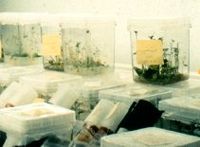
Photo from wikipedia
Interploid crosses display a common approach in plant breeding to vary ploidy level in crops. This research included three trials to determine ploidy purity and genomic stability of diploid, triploid… Click to show full abstract
Interploid crosses display a common approach in plant breeding to vary ploidy level in crops. This research included three trials to determine ploidy purity and genomic stability of diploid, triploid and auto-tetraploid varieties of German chamomile during life-time and across generations after interploid crosses. Impacts of auxin application were evaluated for seed set, germination rate and progeny ploidy. Ploidy was assessed by flow cytometry and chromosome counting. Ploidy purity in cultivars ranged from 64% (‘Lutea’, 4x) to 100% (‘Bona’, 2x), the share of ploidy-deviants was in 4x-cultivars higher (8%) than in 2x (1%). Auxin application resulted in higher seed set in tetraploids only, while the number of progeny did neither depend on cross direction nor on auxin application. Life time genome stability applied for all ploidy levels. Ploidy level of progeny from 2x × 4x crosses was mostly linked to the maternal level. 3x plants bore progeny with diverse ploidy forms, but not with triploidy. However, cultivars should regularly be monitored for conformance to declared ploidy also in awareness of possible unintended contamination.
Journal Title: Euphytica
Year Published: 2019
Link to full text (if available)
Share on Social Media: Sign Up to like & get
recommendations!